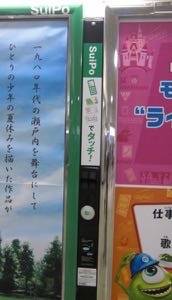This week we’re looking at the world of Smart Cards. Yesterday we checked out the Oyster Card, an RFID-powered smart card that millions of Londoners are using to pay for public transport. It’s one of the largest implementations of RFID in the western world. However perhaps because of that scale, it’s also fairly conservative. Right now the Oyster Card is only used on public transport and there is little Internet functionality available.

We can find a more cutting edge example of smart cards in, where else, Japan. The Suica card – produced by transport company JR East (East Japan Railway Company) – is used on most trains, subways and buses in the Greater Tokyo, Sendai and Niigata regions. It is also used in a variety of micro-payment scenarios.
The main function of the Suica card is payment for train and bus rides. However the card is increasingly being used to make purchases at stores and kiosks within the train stations, as well as in airport stores and taxis. The card is also available as an option at some Japanese e-commerce stores. As of April 2009, over 28 million Suica cards were in circulation. Many people have more than one Suica card, so this number doesn’t equate to the amount of users.

Suica stands for “Super Urban Intelligent Card.” Like the Oyster card, the Suica card uses RFID technology. Also noteworthy is that the Suica isn’t the only smart card option for Japan’s rail system – the Pasmo card is another popular one.
There is a Mobile Suica, enabling Osaifu Keitai mobile phone users to use Suica via their phone instead of a card.
There have been mashups made with Suica data. An example is Sherelog, a service that fetches data from Suica and “visualizes personal train-ride records on a large public map (or Google Map).”
Suica Posters Connect to Net – But Note The Privacy Warnings
Probably the best example of Internet applications built using Suica has been the ‘SuiPo’ (short for ‘Suica Poster’) sites. These are Suica-enabled advertising posters that, when scanned with a Suica card or phone, send further details to your email.

As with anything RFID-related, there are privacy and security concerns. Surveillance expert David Murakami Wood says that while SuiPo are activated by consumers (and so are opt-in), they could also “lead to the accumulation of a lot of data on consumption interests.” He warns that this “potentially generates a massive consumer surveillance tool, because it can be linked up [to] travel patterns.”
Wood helpfully translated the SuiPo webpage on privacy and data protection. He summarizes what Suica can do with user data as follows:
1. Sending the specific requested information to you;
2. Improving services;
3. Data processing and analysis;
4. JR East’s promotional marketing; and
5. JR East customer questionnaires.
Wood wryly notes that “Purposes 2 and 3 pretty much allow JR [East] to do anything it likes with the data.”
Conclusion
As usual Japan is a number of years ahead of western countries in mobile technology. But hopefully this type of functionality on smart cards won’t be too far away in the U.S. and the rest of the world.
To conclude, we recommend you watch these cute Japanese ads to see the full range of uses for Suica:
Image credits: purprin; jpellgen; David Murakami Wood





















